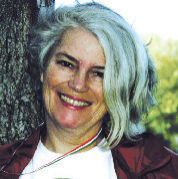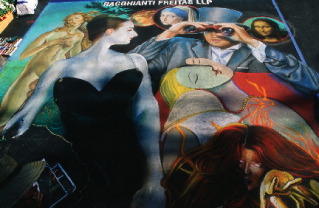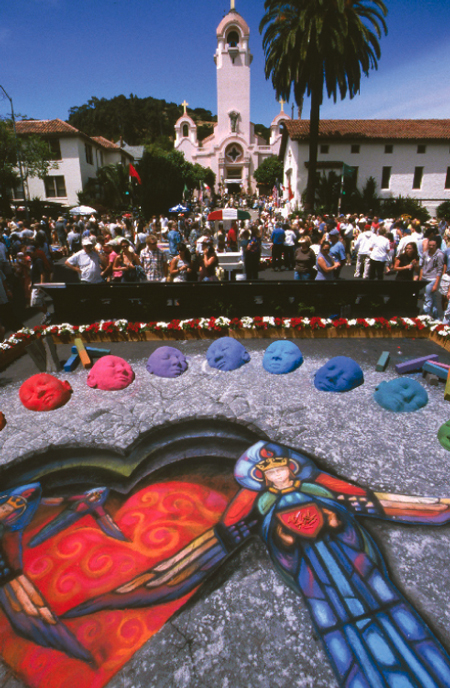Ironically, the fact that Youth in Arts isn’t a household name may be a reflection of its success. The programs it runs span so many disciplines that people aren’t always aware one organization is at the root of them all.
“Youth in Arts is Marin’s most widely known secret,” says Jim Farley, director of Cultural and Visitor Services for the county. “So many people are inspired and educated by their work. But it’s my guess that if you ask the audience after a performance who put this on, they won’t know who’s behind the scenes.”
The nonprofit not only brings visual and performing arts to 85 percent of Marin’s schools through its Artists in Schools and other programs, it also sponsors the Performing Arts Series at the Marin Center, San Rafael’s annual Italian Street Painting Festival and the teen a cappella group ’Til Dawn.
Youth in Arts began in 1970, when Joanne Dunn, Phyllis Thelen and other local patrons of the arts responded to funding cuts that threatened arts education in Marin schools. The first program launched was the Performing Arts Series, an annual season of professional music, theater, and dance matinees created expressly for student audiences.
The Artists-in-Schools program sends mentor artists into classrooms and “runs the gamut from providing a school’s entire music program to finding an artist for a one-time need,” says Youth in Arts executive director Miko Lee. An adjunct program called VSA arts serves special-needs kids.
One purpose of the program is “to train teachers, so they can incorporate art into everything they teach,” says Lee. “We don’t want teachers to see art as a burden, one more thing to add to their plate. Art can be the plate itself.” A portraiture project, for instance, can sync up with a lesson on writing autobiographies.
“Study after study has shown the impact of arts education,” Lee says—and it goes beyond the obvious connections between, say, theater and language arts or rhythmic movement and math. “Arts has a tremendous effect on self-esteem, school attendance and parental involvement. The ripple effect is so broad.”
Thanks to support from the Marin Community Foundation, which gave the organization about $140,000 in grants last year, Youth in Arts is piloting a new program in Corte Madera–Larkspur and Marin City schools called Sequential Thematic Arts Reaching All Schools, or STARS, which will integrate visual arts, music, dance, theater, new media and literary arts into classes over a five-year period. “It provides an organizational and conceptual structure that will infuse the arts into the curriculum in a sequential, cohesive manner,” says Marilyn Clark, principal of Neil Cummins Elementary in Corte Madera. “I believe the potential for positive results is unlimited.” If successful, the program will be implemented countywide.
Two events this summer will showcase the ways YIA enriches the cultural fabric of Marin. On June 14 and 15, the Italian Street Painting Festival in downtown San Rafael will bring together 300 professional artists and 150 performing artists, with the help of 500 volunteers. One of the featured artists will be Mill Valley’s Genna Panzarella, who was part of the 1994 debut festival. She went on to earn the title “maestro,” at the International Street Painting Competition. “There are only a dozen people in the world with the title,” Lee says proudly. She points out that the fair was initially started as a fundraiser but has grown to be so much more. “Now, it’s our gift to the community.”
And July 2 is “Youth in Arts Day” at the Marin County Fair, with free admission for kids 12 and under. YIA has art activities planned throughout the day, along with a gallery maze of student work and a performing arts stage showcasing student and mentor artists. Jim Farley is delighted by the opportunity to honor YIA at the fair. “Youth in Arts was one of the four founding organizations that created the Marin Center,” he says. “They have a special place in our hearts.”
 Genna Panzarella has been a participating artist since Youth in Arts’ first Italian Street Painting event 15 years ago. These days she teaches an after-school chalk painting class as a mentor artist for Youth in Arts at Lynwood Elementary School in Novato as well as an after-school art class at Strawberry and Tam Elementary schools in Mill Valley. Below, Panzarella shares her Italian Street Painting preparation timeline with us, and at right, she comments on her paintings.
Genna Panzarella has been a participating artist since Youth in Arts’ first Italian Street Painting event 15 years ago. These days she teaches an after-school chalk painting class as a mentor artist for Youth in Arts at Lynwood Elementary School in Novato as well as an after-school art class at Strawberry and Tam Elementary schools in Mill Valley. Below, Panzarella shares her Italian Street Painting preparation timeline with us, and at right, she comments on her paintings.
Three months: A good time to gather ideas from images that I would love to draw. I reference my studio library and files of magazine photos looking for ideas.
Two months: I start working on the computer, scanning in the images and moving them around to get a good composition that will work on the sidewalk.
One month: I print out my finished Photoshop image to discuss with others, then rework it to make it exact.
One week: I take the finished image to Kinko’s to print three copies as large as possible. I also enlarge details like faces and hands and laminate for durability.
The night before: I draw a grid on one of my copies, usually approximately an inch for every foot of allotted space for the finished drawing.
First morning: I lay a tape border around my space. Measure out each foot to correspond with the inches on my gridded picture. Ask a passerby to help hold a snapline to set the grid onto the street. The snapline is a chalk-covered string that sets a straight line when you snap it! Fun!
One hour later: I sketch the outline of the drawing by looking where it crosses the lines of grid. I use “Chalk on a Stick,” chalk taped to a long dowel, so I can stand while I draw. If I draw in the wrong squares, I have the ability to erase with a wet sponge and draw it again.
First afternoon: Start the drawing! I start by coloring and emphasizing the sponsor’s name to bring it into the artwork. I always start the drawing at the top and back up as I fill it in. At my age I work best sitting on a cushion with my chalks by my side. Joy!
Last day: I have paced my drawing throughout my allotted time, planning the complexity of the image to fit the time I will have. In my mind I set deadlines along the way to plan more time for faces and hands. The real timeline is in how I plan my time in the drawing. I plan to finish at 6 p.m. on the last day. It is always a rush at the end.
Afterward: When I finish I try to look at it for the first time. Then I find a ladder to take a good photo. The photo is important as it will be all I have later. Hopefully I then have time to enjoy the wonderful work of my colleagues, before racing off to catch a plane!

Man’s Search Through the Centuries for Ms. Right: “It shows a man with binoculars searching a crowd of famous paintings from each century, including Mona Lisa and the Girl with the Pearl Earring. [Dedicated to Sue Carlemagno, who managed the show for 15 years. “Our Ms. Right”]


